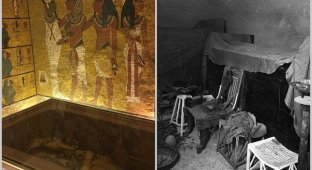What is known about the first workers' strike in history (5 photos)
The history of labor strikes dates back to the 12th century BC. The first strike, about which documentary information has been preserved, occurred in Ancient Egypt during the reign of Ramesses III. 
The events were described in some detail on papyrus that has survived to this day. The scribe Amennakht told how in the 29th year of the reign of the pharaoh (about 1170 BC), the builders and artists of the tombs in Deir el-Medina stopped receiving their salaries (which were given in grain).
On the 18th day, after they were once again not given grain, they threw down their tools, left their jobs and moved towards the city of Thebes. The strikers shouted: “We are starving!” According to the scribe, this was something unprecedented, and local officials did not know what to do. They ordered bread to be given to the protesters, but they did not return to work, but continued to strike the next day, demanding that they be given everything they owed by that time. The law enforcement officers who were called shrugged their shoulders and simply left.
In the end, the strikers were given their due salaries, but very soon it became clear that they could not wait for the next payment again. And the strike was renewed, and this time the protesters blocked the road to the Valley of the Kings and threatened to destroy the royal tombs.
Over the several years that this strike lasted, it moved from ordinary complaints about non-payment of salaries into the category of protests with more serious slogans, for higher justice and against “bad people and bad deeds happening behind the back of the pharaoh.”
But why did workers stop receiving wages on time and in the proper amount? 
Relief of the goddess Isis embracing Ramesses III, from the tomb of Prince Amun-kher-khepeshef
To answer this question, we need to talk about what was happening in Egypt at that time.
Ramesses III inherited the title of pharaoh around 1186 BC. e. as the second pharaoh of the Twentieth Dynasty. He was considered the last great pharaoh of the New Kingdom, a worthy successor to Ramesses II. He protected the country from enemy invasion, and many temples and monuments were built and restored during his reign, and this probably boosted the morale of his people.
However, the state lacked its former strength and power. This was partly due to the decline of the economy that began during the reign of the previous pharaoh Setnakhte. Egypt suffered from a decline in trade and taxes, and its resources became scarcer than before.
Ramesses III was killed during the Harem Plot, a coup d'etat organized by his second wife Tiye, who hoped to place her son Pentawer on the throne. Although those involved managed to kill the ruling pharaoh, they were unable to complete the second part of their mission: Ramesses IV, the son of Ramesses III, gained control of the country. 
Ramesses III defeats the Sea Peoples
Ramesses III reigned for 31 years. Everything was relatively peaceful and prosperous until the attack of the Sea Peoples (a collective term describing people from Western Anatolia, the islands of the Mediterranean Sea, the Aegean Sea, and Southern Europe) occurred. This war depleted Egypt's resources, both financial and human.
The Sea Peoples struggled to reach land during the attack. Ramses III ordered his commanders to create strongholds on the other side of the borders, as well as deploy warships. One of his tactics was to hide archers along the coastline near the mouth of the Nile so that boats could not even enter the river.
His tactics were recorded to have had great success on the seashore, but the records made no mention of a land battle - probably due to the high number of casualties that were not officially recorded. 
Ramesses III celebrates victory over the Sea Peoples
The next few years in the New Kingdom were peaceful, allowing Ramesses III to begin building new temples. He and his entourage also undertook an epic tour of Egypt, further draining the treasury. He also ordered expeditions to nearby foreign lands to establish trade relations and military conquests, which turned out to be successful.
It seems that all these achievements should have been more than enough to replenish the treasury. But no, they were not enough.
Historians believe that the situation that led to the workers' strike can be explained by a combination of severalmany factors. These include large losses of labor as a result of the war, and large expenses incurred in the fight against the Sea Peoples, and corruption among officials that led to improper distribution of resources, and poor harvests due to bad weather. 
Relief with female musicians in the tomb of Kheruef
So here it is. Hungry workers are already on strike, and Ramesses III, meanwhile, decides to organize a grand celebration in honor of the 30th anniversary of his reign. He and his advisers had no idea how to deal with the starving workers, since this had never happened before. Workers were given baked goods and drinks during the celebration. But the next day they resumed the strike.
Since the workers from Deir el-Medina were among the highest paid in the country (they were building the necropolis for the pharaoh himself), their poor treatment suggested that lower-ranking workers had nothing to hope for at all. In the end, the confrontation ended and the strikers got what they were owed. However, by that time, faith in Maat - the concept of harmony - had been undermined.
The concept of Maat said that the “pharaoh and father” maintains order and harmony between people and gods, makes sure that his subjects do not starve and are always at work, and does everything possible to achieve the public good.
The workers' strike that occurred was the beginning of the decline in the power of the pharaoh and the blind devotion of his subjects.























